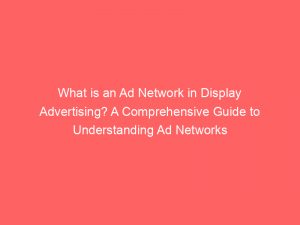In today’s digital landscape, where attention is fleeting and competition is fierce, advertisers are constantly searching for innovative ways to connect with their target audience. Enter the ad network, a dynamic and multifaceted tool that has revolutionized the world of display advertising.
But what exactly is an ad network? In this fast-paced era of online marketing, understanding the ins and outs of these intricate systems is essential.
Join us as we unravel the mysteries of ad networks, exploring how they bring advertisers and websites together, offer a myriad of pricing options, and adapt to the ever-evolving realm of digital advertising. Prepare to dive into a world of strategic marketing and untapped potential!
Table of Contents
- what is an ad network in display advertising
- 1. What Is An Ad Network In Display Advertising?
- 2. Types Of Ad Networks: Vertical, Premium, Inventory-Specific, Targeted
- 3. Cost Of Using Ad Networks: Fixed Rates, CPC, CPM, RTB Auctions
- 4. Ad Networks Vs. Ad Servers: Understanding The Differences
- 5. How Ad Networks Facilitate Buying And Selling Of Ad Inventory
- 6. Generating Revenue: Revenue Share Vs. Marking Up Inventory
- 7. Popular Ad Networks: Google Adsense, Media.Net, PopAds, And More
- 8. The Evolution Of Ad Networks With SSPs And DSPs
what is an ad network in display advertising
An ad network in display advertising is a platform that connects advertisers with websites seeking advertisers. These networks collect unsold ad inventory from publishers and match them with advertisers who want to display their advertisements.
There are different types of ad networks, including vertical networks, premium networks, inventory-specific networks, and targeted networks. The cost of using an ad network can vary, with options such as fixed rates, cost per click (CPC), cost per thousand impressions (CPM), and real-time bidding (RTB) auctions.
Ad networks are different from ad servers as they facilitate the buying and selling of ad inventory, while ad servers deliver and track the ads. Ad networks generate revenue through revenue sharing or marking up inventory prices.
They help advertisers reach their target audience and increase conversions, while also helping publishers secure buyers and fill their ad inventory. Ad networks have evolved with the advent of supply-side platforms (SSPs) and demand-side platforms (DSPs) in digital advertising.
When choosing an ad network, factors to consider are the quality and size of the network, as well as its targeting capabilities. Some popular ad networks mentioned include Google Adsense, Media.net, PropellerAds, and Adcash.
Understanding ad networks in display advertising is crucial as they make it easier to manage and monitor advertising campaigns, and it can be challenging to track ad spending without them.
Key Points:
- An ad network in display advertising connects advertisers with websites seeking advertisers by collecting unsold ad inventory from publishers.
- Different types of ad networks include vertical networks, premium networks, inventory-specific networks, and targeted networks.
- The cost of using an ad network varies, with options such as fixed rates, CPC, CPM, and RTB auctions.
- Ad networks facilitate the buying and selling of ad inventory, while ad servers deliver and track the ads.
- Ad networks generate revenue through revenue sharing or marking up inventory prices.
- Factors to consider when choosing an ad network include the quality and size of the network and its targeting capabilities.
Sources
https://blog.hubspot.com/marketing/what-are-ad-networks
https://www.spiceworks.com/marketing/programmatic-advertising/articles/what-is-an-ad-network-definition-types-and-examples/
https://support.google.com/google-ads/answer/2404190?hl%3Den
https://clearcode.cc/blog/what-is-an-ad-network-and-how-does-it-work/
Check this out:
💡 Pro Tips:
1. Consider the reputation and track record of an ad network before partnering with them. Look for reviews and feedback from other advertisers and publishers to ensure they are trustworthy and reliable.
2. Take into account the targeting capabilities of an ad network. Look for networks that offer advanced targeting options, such as demographic targeting, behavioral targeting, or retargeting, to reach your desired audience effectively.
3. Keep an eye on the pricing options and formats offered by an ad network. Some networks may only offer fixed rates, while others may provide CPC (cost per click), CPM (cost per thousand impressions), or even RTB (real-time bidding) auctions. Choose the pricing model that aligns with your advertising goals and budget.
4. Look for ad networks that provide access to premium inventory. Premium inventory refers to ad space on high-quality, reputable websites that attract a large number of visitors. This can help ensure that your ads are displayed in a brand-safe and credible environment.
5. Don’t be afraid to test different ad networks to find the best fit for your advertising needs. Each network offers unique features and benefits, so experimentation can help you determine which one yields the best results for your campaigns.
1. What Is An Ad Network In Display Advertising?
In the world of display advertising, an ad network is a platform that connects advertisers with websites that are seeking advertisers. Ad networks act as intermediaries between advertisers and publishers, helping to facilitate the buying and selling of ad inventory.
The main purpose of an ad network is to collect unsold ad inventory from publishers and match them with advertisers who are looking to display their ads on relevant websites.
2. Types Of Ad Networks: Vertical, Premium, Inventory-Specific, Targeted
There are different types of ad networks that cater to various needs and preferences. These include vertical networks, premium networks, inventory-specific networks, and targeted networks.
Vertical networks: These ad networks focus on specific industries or niche markets, allowing advertisers to target their audience more effectively. – Premium networks: These networks provide access to high-quality, premium ad inventory on popular websites with high traffic and engagement.
Inventory-specific networks: These networks specialize in specific types of ad inventory, such as mobile or video ads. They offer advertisers the opportunity to target specific formats.
Targeted networks: These networks focus on audience targeting, allowing advertisers to reach their desired audience based on demographics, interests, or behavioral patterns.
3. Cost Of Using Ad Networks: Fixed Rates, CPC, CPM, RTB Auctions
The cost of using an ad network can vary depending on several factors. Advertisers can choose different pricing models that suit their budget and advertising goals.
Fixed rates: Ad networks may offer fixed rates, where advertisers pay a predetermined amount for a specific time period or number of impressions. – CPC (Cost Per Click): In this model, advertisers only pay when a user clicks on their ad.
CPM (Cost Per Mille): Advertisers pay for every thousand impressions of their ad. – RTB (Real-Time Bidding) auctions: These auctions allow advertisers to bid in real-time for ad impressions, with the winner’s ad being displayed.
4. Ad Networks Vs.Ad Servers: Understanding The Differences
While ad networks and ad servers are both essential components of display advertising, they serve different purposes.
- Ad networks: As mentioned earlier, ad networks act as intermediaries between advertisers and publishers. They aggregate impressions from publishers and provide access to premium ad inventory.
Ad networks facilitate the buying and selling of ad inventory and help advertisers reach their target audience. – Ad servers: Ad servers, on the other hand, are responsible for managing and delivering ads to the websites or platforms where they are displayed.
Ad servers ensure that ads are served correctly and track their performance, providing valuable data and analytics to advertisers.
5. How Ad Networks Facilitate Buying And Selling Of Ad Inventory
Ad networks play a crucial role in the buying and selling of ad inventory. They connect advertisers who are looking to display their ads with publishers who have available ad space on their websites.
Here’s how the process works:
Publishers make their unsold ad inventory available to ad networks.
Advertisers specify their targeting preferences and budget to the ad network.
The ad network matches the relevant ad inventory from publishers with the targeting criteria of the advertisers.
Advertisers’ ads are displayed on the selected websites, helping them reach their desired audience.
Ad networks handle the process of tracking impressions, clicks, and conversions, providing advertisers with performance data.
Ad networks earn money through different revenue models, either by sharing the revenue with publishers or by marking up the ad inventory.
Revenue share: In this model, ad networks and publishers split the revenue generated from the ads. The specific revenue share percentage varies depending on the agreement between the ad network and the publisher.
Marking up inventory: Ad networks may also mark up the price of ad inventory before selling it to advertisers. This allows ad networks to earn a profit margin on each ad placement.
7. Popular Ad Networks: Google Adsense, Media.Net, PopAds, And More
There are numerous ad networks available in the market, each offering unique features and advantages. Some of the popular ad networks include:
Google Adsense: Google Adsense is one of the oldest and biggest ad networks, offering a wide range of targeting options. It provides access to a vast network of publishers and advertisers.
Media.Net: Media.Net is a contextual ad network that focuses on serving relevant ads based on the content of a website. It is known for its high-quality ad placements and innovative ad formats.
PopAds: PopAds specializes in pop-under ad placements, where ads appear in a new window behind the current browser window. It offers a large inventory of pop-under ads.
PropellerAds: PropellerAds is a leading ad network that specializes in display and push ads. It offers various targeting options and formats to help advertisers maximize their reach and conversions.
BidVertiser: BidVertiser is an ad network that offers a range of ad formats, including display, pop-under, and native ads. It provides self-serve tools for advertisers to manage their campaigns effectively.
Adcash: Adcash is a DSP (Demand-Side Platform) that focuses on mainstream traffic. It offers advanced targeting capabilities and real-time bidding options for advertisers.
It’s important to note that while these ad networks are popular, the choice of an ad network should depend on individual advertising goals and requirements.
8. The Evolution Of Ad Networks With SSPs And DSPs
With the evolution of digital advertising, ad networks have transformed and integrated with other technologies such as SSPs (Supply-Side Platforms) and DSPs (Demand-Side Platforms).
SSPs focus on helping publishers optimize their ad inventory and maximize their revenue. They enable publishers to connect with multiple ad networks, manage ad placements, and analyze performance data.
DSPs, on the other hand, cater to the needs of advertisers by providing tools and platforms to manage and optimize ad campaigns. DSPs enable advertisers to access multiple ad networks, bid on ad inventory in real-time, and manage targeting parameters.
The integration of ad networks with SSPs and DSPs has brought more efficiency and transparency to the ad buying and selling process. It has also allowed for more precise targeting and improved results for advertisers and publishers alike.
In conclusion, understanding ad networks in display advertising is essential for advertisers and publishers looking to maximize their reach and revenue. Ad networks provide a platform for connecting advertisers with websites seeking advertisers and facilitate the buying and selling of ad inventory.
They offer various pricing models, targeting capabilities, and ad formats to cater to individual needs. With the evolution of SSPs and DSPs, ad networks have become more advanced and efficient, providing valuable tools and options for advertisers and publishers in the ever-changing landscape of digital advertising.












